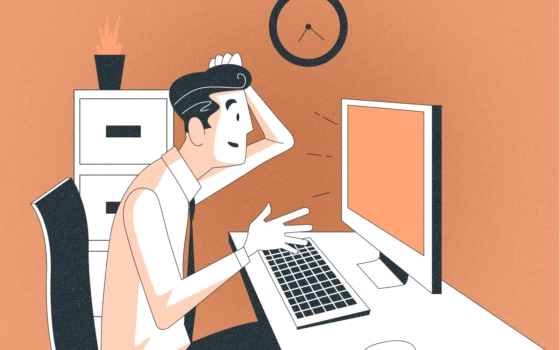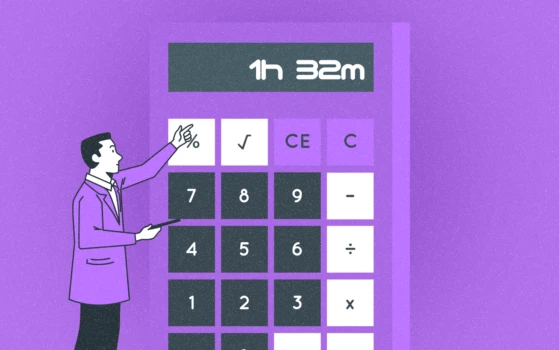
How to Handle Procrastination While Working Remotely
The first thing we need to establish is the fact that procrastination is thought to come from an emotional reaction to whatever it is you are avoiding.
Researchers call this phenomenon “mood repair”, where we avoid the uncomfortable feelings associated with our work by spending time on mood-enhancing activities, like playing games or spending time on our phones.
“In a nutshell, we procrastinate because our brains are wired to care more about our present comfort than our future happiness.”
The phenomenon of putting stuff off, it’s a “merely visceral, emotional reaction to something we don’t want to do”, says Dr. Tim Pychyl, author of “Solving the Procrastination Puzzle”. The more averse you find a task, the more likely you are to procrastinate.
In his research, Dr. Pychyl states that there are seven triggers that make a task seem more averse. Bring to mind something you are putting off right now – you’ll probably find that task has many, if not all, of the characteristics that Dr. Pychyl discovered, makes a task prone to procrastination:
- Boring
- Frustrating
- Difficult
- Ambiguous
- Unstructured
- Not intrinsically rewarding (i.e. you don’t find the process fun)
- Lacking in personal meaning
On a biological and neurological level, procrastination is not even remotely logical – it’s the result of the emotional part of your brain, your limbic system, strong-arming the reasonable, rational part of your brain, your prefrontal cortex. The logical part of your brain surrenders the moment you chose a distraction over the task you needed to finish at that specific point in time.
There are a few ways you can give the logical side of your brain the “upper hand”. When you notice an approaching showdown between logic and emotion resist the impulse to procrastinate. Here are the best ways I’ve discovered in my research to do that:
How can you overcome your procrastination habit easily?
Reverse the procrastination triggers
Consider which of Pychyl’s seven procrastination triggers are set off by an activity you’re dreading. Then try to think differently about the task, making the idea of completing it more attractive. Let’s say that you are supposed to work on a project that is completely ambiguous and unstructured, you could create an easy workflow that lays out the exact “small steps” you should follow along the way in order to be able to accomplish its completion.
Work within your resistance level
When a task sets off procrastination triggers, we resist doing it. But we have to perform an initial assessment to determine how resistant are we?.
Let’s say you have to navigate through a large research document for an upcoming project. To find your resistance level, consider the effort you commit to that task along a sliding scale. For example, could you focus on reading for an hour?. No, that period of time still seems unpleasant. How about 30 minutes?. Shorten the amount of time until you find a period threshold you don’t feel resistant to the task any longer and then act upon that.
Disconnect
Our devices offer a cornucopia of distractions, whether it’s email, social media, or chat with friends and family. This is especially difficult as our work becomes more ambiguous and unstructured ( two of the triggers of procrastination ).
When you realize you are using your device to procrastinate, disconnect. Sometimes you can take drastic measures such as leaving your phone in a distant room from you, and if that is not enough you can use apps like Freedom or Self Control, which will block access to distracting sites and will require you to physically restart the computer altogether in order to “restore” access to those distracting sites. Although this might seem too radical when you disable digital distractions ahead of time this will give you no choice but to work on what’s really important.
Make the process to get started an easy task
To overcome our psychological aversion to uncomfortable tasks, it is suggested that we should “make the threshold for getting started quite low” and just get started. Most of the time starting a specific task is the biggest hurdle to overcome. Researchers say that “a real mood boost comes from doing what we intend to do the things that are important to us”. Knowing this, we can reason that although getting started might feel uncomfortable, we are likely going to feel much better once the task is done. Compare the mood boost of having completed what you were trying to do, to the disappointment and frustration of dealing with the consequences of procrastination later.
Research shows that progress -no matter how small- can be a huge motivator to help us keep going.
Do the right thing for the wrong reason
Since negative emotions are the cause of our procrastination, what if we could manage our negative emotions while working?. Behavioral economist Dan Ariely calls this method reward substitution, while Katherine Milkman, another behavioral economist, calls it temptation bundling.
Reward substitution, as described by Ariely, is essentially getting yourself to do the right thing for the wrong reason. The reason this works is that, according to Ariely, humans aren’t wired to care about things that will happen far into the future. While it would be in our best interest to think about the future, we are always focused on what makes us feel good now. This is essentially what makes it hard to do unpleasant things which would benefit us in the future.
Ariely uses global warming as an example of a future problem. It’s hard to care about global warming because we don’t see the signs of it regularly, we don’t see people suffering, and it’s not going to affect us seriously until far in the future. But if you feel self-important when you drive a hybrid car, because it makes you feel like you are a good person, and it shows others that you’re a good person, then you might be more likely to do so. You’d be doing the right thing ( switching to a hybrid car ) for the wrong reason ( your self-image ).
Ask for help
When your work directly affects others, it is harder to accept the consequences of procrastination. To put this into practice, you could ask a friend or colleague to help you get started on something you’ve been putting off. Having someone else work with you can stave off boredom and loneliness that make working alone a hassle. When you have someone else invested in the work can give you extra motivation to get it finished, even if they are not around the whole time you are working on it.
This can be particularly helpful when you are stressed. Research has shown that discussing your feelings of stress with someone else in a similar emotional state can ease your feelings of stress. So if you are working with other people and you are worried about an upcoming deadline, try discussing the situation rather than internalizing your own concerns.
Imagine the future
Although it seems we are “doomed” to think about the present above it all, some studies have shown encouraging people to imagine the future can help make better decisions now.
Dr. Tim Pychyl, author of “Solving the Procrastination Puzzle” calls this method “time travel”. He suggests, for instance, imagining as vividly as possible the idea of living on your current retirement savings, if saving for retirement is something you’ve been putting off.
Unfortunately, Pychyl suggests we may procrastinate on this task itself, which he calls second-order procrastination- procrastinating on tasks that would help us overcome our procrastination. Pychyl also worries the emotional reaction of the time travel method, which helps us get into action, might easily wear off over time.
Making the task of time travel more concrete can help its effectiveness. Pychyl suggests looking at a digitally aged photograph camera helps us more effectively imagine ourselves in the future, thus helping us make better decisions.
Another way to use this method is to really imagine how you’ll feel tomorrow if you are trying the old “I feel like doing this tomorrow” excuse. Pychyl says it’s highly unlikely we will feel more motivated tomorrow so time traveling may help us realize this, and stop relying on the “tomorrow” excuse.
Reframe your tasks and deadlines
Have you ever tried to trick yourself to get your work done? One interesting approach is to pretend that the deadline is actually today, not tomorrow, so you would have gotten it started earlier.
Another study of procrastination found reframing the task itself, rather than adjusting its deadline, was effective in helping procrastinators get to work. Participants in this study were asked to complete a puzzle but were allowed to play Tetris for a while first.
When the puzzle was described as “cognitive evaluation”, procrastinators spent more time playing Tetris and avoiding the puzzle. When the puzzle was introduced as a game, however, the chronic procrastinators in the study got sucked into the puzzle as quickly as anyone else. You might not always be able to convince yourself that your work is a game, but look for ways to reframe it.
Internal motivation, on the other hand, does not cost us. We still have to exert ourselves to get the work done, but if we are working from internal motivation it won’t feel draining. Pychyl suggests thinking of your task as something you want to get done, to help adjust your motivation to be more internal. When you care about getting something done for your own sake, rather than a deadline or external expectation, you can more easily find the effort required to get started.
Let yourself avoid uncomfortable tasks
If you can’t stop procrastinating, the silver lining is that you can use this “bad” habit to your advantage. “Structured procrastination” is a clever way to stay productive even while you procrastinate.
John Perry wrote about this technique, calling it “an amazing strategy that turns procrastinators into effective human beings, respected and admired for all that they accomplish and the good use they make of time”. According to him, the key to understanding structured procrastination is recognizing “that procrastinating does not mean absolutely nothing”.
Next time you feel the urge to procrastinate, go for it. Avoid that “big scary task” that makes you feel really uncomfortable. But instead of spending time on your phone or “watching Netflix” work on something else productive. Choose anything else from your task list, and spend your time procrastinating by working on a less important or urgent task that makes you feel less uncomfortable.
Investor and entrepreneur Paul Graham uses the term “good procrastination” to mean working on more important things that you’re avoiding. He says that working on errands or unimportant tasks to avoid your real work is “bad procrastination” whereas “good procrastination” is avoiding errands to do real work. He breaks down procrastination into three types, depending on what you do instead of that “big task you are avoiding”:
- You do nothing
- You do something less important
- You do something more important
The trick to “good procrastination”, according to Graham, is avoiding the less important, more urgent things on your to-do list ( which he suggests maybe everything on it ) to work on really important work. Your next big idea. The book you keep saying you want to write. The side project you believe in, but can’t find the time for.
Use a timer
One smart and easy way to overcome procrastination is to “break” your schedule into small chunks of time establishing specific thresholds to fully concentrate on a specific task and then taking small breaks in between. Let’s say that you work for 30 minutes straight and then take a 10-minute break, although this might seem “silly” using this short-term reward system could make a big difference when it comes to working on your procrastination habits.
This might sound similar to the “Pomodoro Technique”. If you haven’t heard of it, Pomodoro works with a simple kitchen/phone timer to set a 25 minutes timer to work on a specific given task; once the timer goes off you can take a 5 minutes break.
The 25-minute work sprints are the core of the method, but a Pomodoro practice also includes three rules for getting the most out of each interval:
- Break down complex projects: If a task requires more than four Pomodoros, it needs to be divided into smaller, actionable steps. Sticking to this rule will help ensure you make clear progress on your projects.
- Small tasks go together: Any tasks that will take less than one Pomodoro should be combined with other simple tasks. For example, “write a check”, “set the dentist appointment”, and “read an article” could go together in one session.
- Once a Pomodoro is set, it must ring: The Pomodoro is an indivisible unit of time and cannot be broken, especially not to check incoming emails, team chats, or text messages. Any ideas, tasks, or requests that come up should be taken note of to come back to later.
Try Monitask
Track employee productivity and simplify work with them






